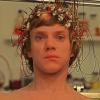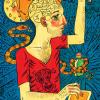
Dysregulation of the neuronal nicotinic acetylcholine receptor (NNR) system has been implicated in attention-deficit/hyperactivity disorder (ADHD), and nicotinic agonists improve attention across preclinical species and humans. Hence, a randomized, double-blind, placebo-controlled, crossover study was designed to determine the safety and efficacy of a novel a4b2 NNR agonist (ABT-894 (3-(5,6-dichloro-pyridin-3-yl)-1(S),5 (S)-3,6-diazabicyclo[3.2.0]heptane)) in adults with ADHD. Participants (N=243) were randomized to one of four dose regimens of ABT-894 (1, 2, and 4mg once daily (QD)) or 4mg BID) vs placebo for 28 days. Following a 2-week washout period, participants crossed over to the alternative treatment condition (active or placebo) for an additional 28 days. Primary efficacy was based on an investigator-rated Conners' Adult ADHD Rating Scale (CAARS:Inv) Total score at the end of each 4-week treatment period. Additional secondary outcome measures were assessed. A total of 238 patients were assessed for safety end points, 236 patients were included in the intent-to-treat data set, and 196 were included in the completers data set, which was the prespecified, primary data set for efficacy. Both the 4mg BID ABT-894 and atomoxetine groups demonstrated significant improvement on the primary outcome compared with placebo. Several secondary outcome measures were also significantly improved with 4mg BID ABT-894. Overall, ABT-894 was well tolerated at all dose levels. These results provide initial proof of concept for the use of a4b2 agonists in the treatment of adults with ADHD. Further investigation of ABT-894, including higher doses, is therefore warranted.
http://www.ncbi.nlm....les/PMC3547191/
Attentional impairments are found in a range of neurodegenerative and neuropsychiatric disorders. However, the development of procognitive enhancers to alleviate these impairments has been hindered by a lack of comprehensive hypotheses regarding the circuitry mediating the targeted attentional functions. Here we discuss the role of the cortical cholinergic system in mediating cue detection and attentional control and propose two target mechanisms for cognition enhancers: stimulation of prefrontal a4b2* nicotinic acetylcholine receptors (nAChR) for the enhancement of cue detection and augmentation of tonic acetylcholine levels for the enhancement of attentional control.
While the literature on specific a4b2* agonists in humans is sparse, these agonists appear to have more robust attentional enhancement effects than those seen with nicotine in patient populations such as age associated memory impairment (Dunbar et al., 2007) and schizophrenia (Taylor et al. 2011). Interestingly, clinical trials on the a4b2* agonist ABT-089 demonstrate this agonist can robustly improve attention in adult ADHD patients (Wilens et al., 2006; Apostol et al., 2012), but not in pediatric ADHD patients (Wilens et al., 2011).
http://www.ncbi.nlm....les/PMC3445745/
What do you think?
Edited by mice, 04 April 2014 - 05:12 PM.






















































